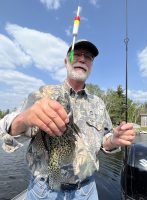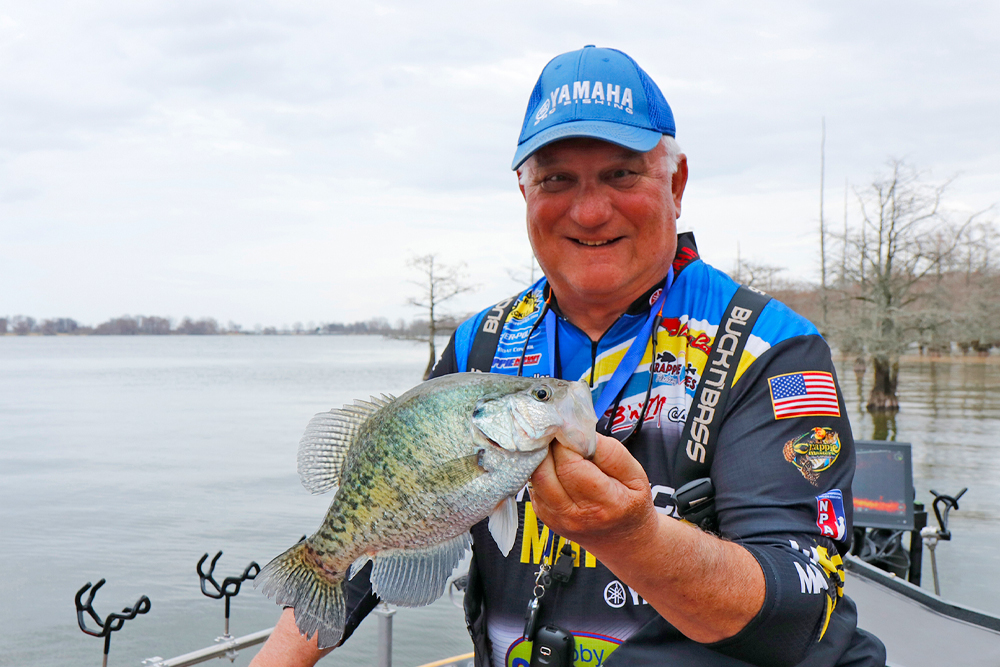Dan Dannenmueller said electronics are great tools, but a fisherman can also catch fish the old
fashioned way. Minnows are an important part of the combination when fishing slowly. (Photo: Tim Huffman)
Breaking the Rules for More Crappie
by Tim Huffman
There are basic rules-of-thumb we all use when fishing for crappie. For example, use bright-colored baits in light conditions, or avoid fishing when the cows are laying down. However, crappie don’t always follow the rules, so six experts share their ideas on when breaking the rules can lead to more crappie in the livewell.
Rule: You Must Have Live-Imaging Sonar
“Fishermen say (live-imaging sonar, LIS) is required in today’s fishing,” said Sam Heaton, guide, and industry pro. “It’s good and has really changed our sport but it’s not for everyone. You can still catch plenty of fish without it. We caught crappie for years by trolling, jigging, casting and other ways. I suggest that a weekend fisherman without (LIS) stick to the basics by fishing visible structure like boat houses, trees, docks, stumps and anything else that’s visible. Use one pole and 15-pound-test braided line. Braided line is so sensitive it lets you feel so many more bites and catch more fish.”
Rule: Crappie Always Relate to Cover

“Not always,” said CrappieNOW Publisher and professional crappie fisherman, Dan Dannenmueller. “There are many factors like the type of water, shade and fishing pressure. The fish have learned that they must be careful when boats are in the area. They’ve also learned that when they are on cover, they are more likely to be caught. (Live-imaging sonar) shows us that looking 20-to-40 feet from the structure will likely reveal good fish. So, it’s important to check cover, but don’t ignore more open areas, especially between cover, because we’re learning that fish can be anywhere.”
Rule: The Best Fishermen Only Use Jigs
“There are a few fishermen who won’t use minnows,” said Dannenmueller. “However, I would guess 85 to 90 percent of pros and guides also use minnows. Jigs are great when fish are active. You don’t have to buy and mess with minnows. But there are a lot of times when a crappie will hit a minnow when they won’t touch a jig. The two ways I usually use minnows are when spider rigging and slip corking. I’ll spider rig using a double-hook rig with a plain minnow on top and a minnow on a Road Runner head on bottom. The other way I fish minnows is under a slip float. A slip float can be fished any depth, so it is a year-round bait. Jigs are good, but a minnow can save the day and catch fish.”
Rule: Don’t Vary from Standard-Type Baits
“Not true,” said northern fisherman, Tom Peterson. “I fish northern lakes for all species. Al’s Goldfish, a minnow shaped, curved spoon, will catch crappie on a cast and retrieve. It has a good action that attracts and triggers bites when you find a school of crappie. When that doesn’t work, I’ll use it under a float as an attractor. I’ll remove the hook, then tie a short leader about six inches long, tie a hook to the leader and attach a small minnow. It works great for crappie. It also catches anything else that swims.”
Rule: Crappie Always Feed Up
Barry Morrow, pro fisherman and Truman Lake guide, said, “That’s one of the biggest ‘not true’ rules. Crappie have eyes in the top of their heads so it’s easier for them to see up and see a bait. That part is true. However, they can see bait go down past them and when they are hungry, they are going down to find it. They will go down to eat a bait, especially when they are hungry and aggressive.”
Rule: Dark Colors in Dark Conditions; Light in Bright
Barry Morrow said, “On a recent trip with you to Truman Lake, we caught fish on black-chartreuse in the middle of the day on a bright, sunny day. The key thing to remember is that colors can change day-to-day. The rule of thumb is a good one most of the time, but you must be open to changing colors. Manufacturers make all the different colors for a reason.”
Rule: Stick with Your Favorite Jig Colors

“I won a tournament on Truman Lake several years ago,” said Morrow, “because you went with me the day before the tournament and used a color I never use. You caught three big black crappie on it when I wasn’t catching anything that day. Both mornings of the tournament, my partner and I used that color to catch all our good fish. Be sure to try different colors when fishing is tough.”
Rule: The Best Time to Fish is During the Spawn
“The spawn can be good with the chance to catch some big fish,” said Santee Cooper guide, Matthew Outlaw. “However, for me, summer is the best season for consistent catching. Learn a pattern and you can catch fish with that pattern most of the summer and into the fall. There are many ways to catch them, but I like a slip cork because it works and is very simple. Fish may gang up on cover and you can stay in one spot and catch a limit.”
Rule: When the Cold Frost Hits, It’s Time to Go Deep
“Fish can be at different depths in summer, fall and winter transition,” said Pico Lure owner, Mitch Glenn. “However, the first freeze is the time to look shallow. The first hard freeze sends a signal to the fish that it’s time to get serious about feeding to prepare for winter. When the freeze hits, insects and crawdads look for a warmer place to be and that is in the water. Fish will get shallow watching for these easy meals. For one to four weeks, the shallow water bite can be great. Early morning and late afternoon are usually the best times for the shallow fall bite.”
Closing
Crappie always follow rules, until they don’t. The best plan is to use good basics for fishing but when fishing gets tough, don’t be afraid to buck the rules to find and catch crappie.
Tim Huffman is CrappieNOW co-founder and senior writer. His crappie-fishing books are available in Kindle or paperback at Amazon.com.


